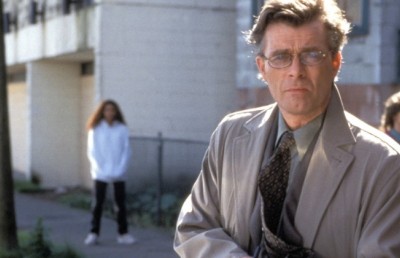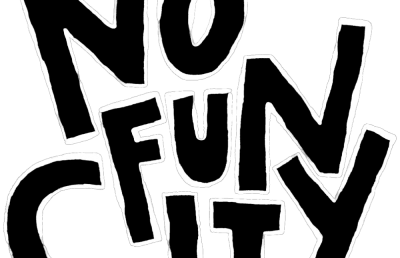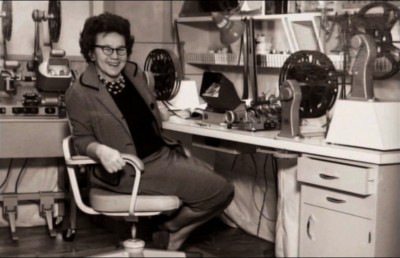Contextualizing Questions of Identity and Space in Mina Shum’s Double Happiness
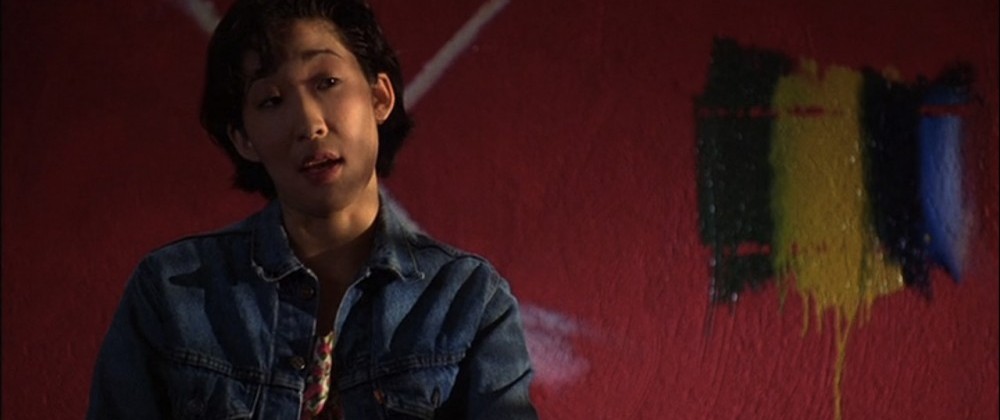
In Double Happiness (1994), writer-director Mina Shum offers a vision of Vancouver as a series of spaces tied to the questions of identity that Jade Li (Sandra Oh), a young aspiring actress under pressure to marry from tradition-minded Chinese immigrant parents, works through during the course of the story. The result is a film that shares important narrative and thematic content with other films about diasporic North American communities from roughly the same period, but comes to a significantly different conclusion regarding the receptiveness of the host community and the nature of the support to be found in the diasporic community. The reasons for this can be found in the ways the film represents Vancouver and expresses its specificity by reflecting in both its narrative and formal choices the social, political and historical contexts in which it was made.
The first of the filmic spaces found in Double Happiness is defined by its ethnicity, being entirely Chinese and primarily represented by Jade’s family home. Mostly interior sets, they are presented as confined and constricted territory, where all concerned feel obliged to act out rigid rules of behaviour in order to live according to a strict and specific definition of “Chinese.” The second of the Vancouver spaces are those areas where different ethnicities interact. These are often photographed to emphasize the dark blues and blacks of their settings, which are strikingly different from the bright reds and yellows of the Chinese areas. Where Jade’s life in her home spaces is an ongoing performance of a version of her ethnic identity with which she feels increasingly at odds, the intermediate space is one where she performs professionally. However, success as an actress within this space must be achieved while dealing with racist assumptions that attempt to place limits on her ambitions and talent, which are different, but analogous to those of her home environment. The third space Shum creates is an idealized Vancouver, a liberated territory where performing is no longer necessary and people can be themselves and fulfill their dreams. These scenes are usually, but not exclusively, exteriors and are introduced by shots that place Jade within a larger open space that emphasizes the possibility of freedom.
To illuminate what is distinctive about Shum’s version of Vancouver, it is useful to place Double Happiness in a series of contexts. The necessary background to understand these contexts is the growth in the ethnic Chinese population in Vancouver, particularly since the 1970s, and the consequent change in its demographic makeup and the residential character of parts of the city, as well as the legacy of racism the community has had to deal with. Against this background, the first context is the evolving cinematic representation of Vancouver’s Chinese community, with representative texts that run from the crude stereotypes of Secrets of Chinatown (1935, Fred C. Newmayer) through the patronizing liberalism of Vancouver’s Chinatown (1954, Bernard Devlin) and on to the “insider” view of Double Happiness. This insider point of view is central to the second context to be examined, which is to situate Double Happiness among the series of films that began to appear during the early1990s in which, for the first time, Canadian visible minority filmmakers were telling stories about their own communities. Comparing Shum’s work to the Toronto-set film Bollywood/Hollywood (2002, Deepa Mehta), and the ways that similar themes and conflicts are very differently addressed in the two films, helps to illuminate Shum’s relationship with her community. Having looked at how Vancouver as a film city relates to the way Chinese Canadian identity is defined in Double Happiness and elsewhere, the final context examines how Shum’s film presents Vancouver’s Chinese community as a diasporic outpost, part Canadian but also part of a larger transnational community. A discussion of how Chinese American films such as Wayne Wang’s Chan Is Missing (1982) and Dim Sum (1985) define their community’s relationship to their urban spaces offers a final contrast to Shum’s ambivalent relationship to her ethnic heritage.
The Chinese and Multiculturalism in Vancouver
There has been a Chinese presence in Vancouver since the 1880s, or as long as there has been a Vancouver. Immigrants arrived from China to work on the construction of the Canadian Pacific Railway and many stayed on for seasonal work. They were overwhelmingly adult males, and in 1901 there were only 60 women and children out of a population of approximately 2000 (Ng 10-11). Despite this and a discriminatory “head tax” levied on the Chinese to discourage immigration, their number had grown to 3500 by 1911. Further spurts of immigration before and after World War I increased the size of the community to 6500 by 1921, including around 600 women and a sharp increase in children, 500 of whom were in public schools (Ng 14). This increased visibility led to a racist backlash and the enactment of the Chinese Immigration Act in 1923, which stopped almost all Chinese immigration until the law was repealed in 1947. The momentum of the earlier immigration increased Vancouver’s Chinese population to 13,000 by 1931, but deaths and Depression-era returns to China brought the number down to 7000 by 1941 (Ng 16). Even under the extremely limited immigration allowed after 1947, the community’s numbers began to show steady growth, up to 8700 in 1951, 15,000 in 1961 and over 30,000 by 1971 (Ng 23). The replacing of racially discriminatory immigration criteria with a points system in 1967 opened the way for a wave of new immigrants, increasing the number of Vancouver’s Chinese to 83,000 in 1981 (Jim 334; Ng 122) and to over 300,000 of the city’s 1.8 million population by the time Shum made her film in 1994 (Ng 137).
For much of the period up to the 1950s, the Chinese residential and commercial presence in Vancouver was centered on the downtown area, which quickly became known as Chinatown. This ethnic ghetto reflected, as Nicholas Blomley writes, “the generalized racism operative within Vancouver society that curtailed, both informally and formally, the spaces within which racialized groups could locate within the city” (147). As a result, even though the post-World War II era was relatively more tolerant and was marked by Chinese Canadians gaining the right to vote in 1947, the first attempts of Vancouver’s Chinese to move into largely white neighbourhoods in the late 1940s and early 1950s were met with extreme resistance. However, the central downtown location of Chinatown and the adjoining district of Strathcona became a target for urban redevelopment beginning in the mid-1950s, leading on the one hand to a partially successful struggle to preserve most of the area (Ng 101-102), but also to a more general dispersal of the Chinese community to the new suburbs (Ng 50). Paul Delany argues that the result was an urban development pattern in Vancouver that differed from older North American cities in that “ethnic neighbourhoods like Chinatown . . . are essentially marketplaces, whose customers drive in from elsewhere” (7). He further points out about Vancouver that “residentially, ethnic groups are highly dispersed, with no sharp demarcation lines between neighbourhoods” (7). This argument suggests that Vancouver’s Chinese, as well as other visible minorities, have been successfully integrated into the host community.
Double Happiness offers a portrait of Vancouver’s Chinese that partially disputes this claim. Jade’s family does indeed live in what appears to be an ordinary, non-racialized suburb. However, it is significant that there is no interaction with neighbours, as Shum’s Chinese, or at least the older first generation immigrants, primarily speak Cantonese, eat only Chinese food, shop only in Chinese stores and socialize only with other Chinese. While Jade’s father Quo (Stephen Chang) presumably interacts with non-Chinese when he works as a security guard, this is never shown on screen. Instead, the ideal of remaining separate from the larger Canadian society is suggested by the fact that one of the paragons Jade’s parents try to match her with is a doctor who has a practice on Pender St. This is a long street that cuts through a variety of Vancouver neighbourhoods. If this were a film about a white Vancouver family, the suggestion that this is an impressive address would likely lead to the assumption the doctor’s practice is on West Pender, in the heart of the financial district. However, given the emphasis on Chinese identity in this home space, the reference is clearly to East Pender, which is in Chinatown. Delany’s version of Vancouver suggests this is a false portrait, as he writes (in the same year the film was released) that in Vancouver, “ethnics do not live a unitary life within an old-world cultural enclave; instead, we all cross and re-cross ethnic borders every day” (7). As Shum has stated that her film is at least partly autobiographical (Gasher 131), even allowing for exaggeration, the perception of ethnic interaction in Vancouver seems to differ sharply depending on which side of the ethnic divide the observation is made from. It is also possible that the increasingly visible presence of the Chinese in Vancouver may have created a paradox in which their increased population meant that non-Chinese residents experienced an unprecedented level of contact with Chinese residents at the same time as it became much easier for many Chinese to live in an almost entirely Chinese milieu.
This increased presence also provided an interesting context for the making of Double Happiness that may have influenced its content. The spike in immigration in the 1980s and early 90s was in part due to an influx of wealthy immigrants from Hong Kong. Related to this was the creation of a new category of “investor immigrant” in 1994 to tap into the flight of wealthy Hong Kong residents emigrating in the face of the imminent handover to the People’s Republic of China in 1997 (Levitin 2007: 274). These newcomers, not having had to deal with the level of racism that previous waves of immigrants had faced, did not feel the traditional need to keep a low profile. They had a major impact on the city’s skyline through the “Hong Kong High Rise” boom that began in 1988 and in part led to the popularity of the term “Hongcouver” (Jim 335). This in turn led to a series of stories in Vancouver newspapers warning of a “Chinese takeover” of the real estate market and created what Jacqueline Levitin describes as a “climate of xenophobia” in which Double Happiness was made. She argues that this explains the film’s cultural politics, which “reaches out to say ‘we Chinese are harmless and essentially just like you’” (2007: 274). The film’s argument is actually more complex, since it draws a distinction between a traditional older generation and a restive younger one. While both are “harmless,” the film suggests that the similarities between second-generation young adults and their non-Chinese (white) counterparts would be more evident if there were fewer barriers within and outside their community.
In a sense, Double Happiness was already dated when it was made. While it was released in 1994, it is actually set a few years earlier. Accepting Shum’s characterization of the story as inspired by her own life, Double Happiness would then be taking place in 1987, the year Shum turned 22, the age of her alter-ego Jade in the film’s narrative. So while the film was made during the storm over the new wave of immigrants, it largely does not deal with this wealthy and self-confident group, with the possible exception of the arrogant Hong Kong film producer, played by Shum, who questions whether Jade can be called Chinese at all. As Levitin points out, Shum identifies with the 1960s cohort of immigrants to Vancouver “who, in Canada, were lower middle class and had to work their way up in the world” (2007: 276). This older generation are security guards, like Jade’s father, or shopowners like her employer, Mrs. Mar, who want their children to be (or at least marry, if they are female) doctors or lawyers, which are the professions of the young men who are set up on dates with Jade. The film can be seen as catching a transitional moment, the coming of age and increasing assimilation of the children of the 1960s immigrants who grew up as a self-conscious minority, just before the arrival of the mass of new immigrants beginning in the late 1980s. This may also explain why, in a film about Vancouver’s Chinese community, none of the exterior scenes include a single shot of the remade Vancouver skyline that even by 1994 had become synonymous with their impact on the city, because the story takes place before it changed.
Another contextual wrinkle that frames the relationships within the community Shum portrays is the Canadian federal government’s policy of multiculturalism, which was inaugurated in 1971 and had both positive and negative effects. The stated goal was to broaden the definition of Canadian identity beyond that of the so-called “founding nations” of English and French to include minority ethnic groups and paved the way for inclusion of the First Nations peoples who had already been here when the “founders” arrived, and was an explicit rejection of the assimilationist model. As Delany writes, multiculturalism is an “official myth” that espouses “the simultaneous preservation of old-country values and affirmation of an encompassing Canadianism” (7). Wing Chung Ng describes multiculturalism as a “nation-building project” that, “by encapsulating the rising ethnic sentiments in the Chinese minority and by reaffirming a sense of belonging to Canada, a Chinese-Canadian identity quickly emerged as a common reference point” (125). In this sense, the policy was a success, although a measure of its success, and the ambivalent nature of that success, is reflected in the film by a generational fissure between the younger characters who feel Chinese-Canadian and the older ones who remain Chinese in Canada. As Mike Gasher argues, Jade and the other young Chinese are largely assimilated, as “they speak Cantonese as a second language, if they speak it at all, listen to Western music, frequent the same Vancouver clubs as non-Chinese, and aspire to professional careers” (131). However, Levitin argues that there was a negative impact of multiculturalism, since it “fossilized the imported culture at the moment of importation” (2007: 275). In Double Happiness, this effect is illustrated by having Ah Hong (Donald Fong), Quo’s boyhood friend visiting from Hong Kong, being less traditionally Chinese than the diasporic immigrants who had not seen China in decades, his openness to change signaled by his learning English and his kissing Jade’s mother’s hand on his arrival because he had just seen the gesture in the airplane movie and had liked it. This is in contrast to Jade’s father Quo who, as Eleanor Ty points out, “has taken a notion of Chineseness, even though this no longer resembles the ethos of his homeland, and attempts to embody this ideal through his daily habits and roles” (80). This is the source of his insistence on tradition. Ah Hong can become more westernized without becoming less Chinese because he is evolving along with a Chinese society that surrounds him. For an immigrant, abandonment of tradition means assimilation into the non-Chinese host community and abandonment of the distinctiveness and solidarity that provide defenses against racism and provide an anchor of continuity among the many changes required of newcomers.
Another problem with multiculturalism that Levitin points out is that in practice it turned out to be less inclusive than its rhetoric. She argues that it “often amounted to no more than conserving the folkloric and stereotypic aspects of a cultural diversity” and that inclusiveness as practiced by most non-Chinese Canadians is focused on exotica, and “remains circumscribed to (a rather Westernized) Chinese cuisine; perhaps the ability to recognize a lion dance; and ‘Dim Sum’” (2007: 275). The result, as expressed in the movie, is that the theory of multiculturalism gives Jade the belief in the possibility of playing Blanche DuBois or Joan of Arc, but the reality is that a casting director can only see her as Chinese, and asks her to do her lines with a stereotypical Charlie Chan-type Chinese accent. As Ty writes, the film “is supremely self-conscious in the way it makes visible the gap between what Jade herself sees and feels and the different images of her identity imposed by both her traditional Chinese parents and Anglo-Canadian society” (192).
This sensitivity to how the larger white community perceives the Chinese minority speaks to the question of the film’s relationship to its audience. Levitin, in keeping with her analysis of the film as a narrative expressing the “harmlessness” of Chinese Canadians, suggests that Shum seeks to frame Jade’s rebellion in a way that non-Chinese audiences can identify with. Jade’s direct to camera comment that her family is “very Chinese, if you know what I mean” draws a link between her and the viewer that excludes the “very Chinese” characters, such as her father, that the film presents. Further, Mark (Callum Keith Rennie), the nerdy white graduate student who Jade takes up with, turns out to be rebelling against his father as well. As Levitin writes, “all families are found to be patriarchal – her Chinese friend Lisa’s as well as Mark’s; the problem is posed as generational rather than cultural” (2007: 277). However, the film’s messages are more complex than Levitin suggests. Brenda Austin-Smith agrees that the use of direct address aligns viewers with Jade’s point of view, but argues that “the phrase ‘If you know what I mean’ signals the multiple audiences Jade has in mind, including those whose knowledge arises from similar experiences of family membership and those whose ‘knowledge’ is, perhaps, rooted in stereotypes” (207). That Shum is aware of these multiple audiences is shown by her comment about the experience of watching her films and hearing “trickles of different laughters in the crowd, depending on what cultural background that person came from” (Spaner 138). It is also important to note that Mark’s single and brief remark about his father is given much less weight than the repeated comments about Chinese parents, particularly fathers, not only by Jade, but also by almost every young Chinese character. Gasher also argues that “the conflict isn’t simply inter-generational,” pointing to the role of Ah Hong, a sympathetic elder who gives Jade the blessing and encouragement her father refused (132).
Cinematic Portraits of Vancouver’s Chinese
The preoccupation with exotica and ethnic stereotyping that Levitin notes in her critique of multiculturalism can be traced through cinematic portraits of Vancouver’s Chinese community. Although there are extremely few portraits to study, films from different eras can be found that reflect their times in interesting ways.
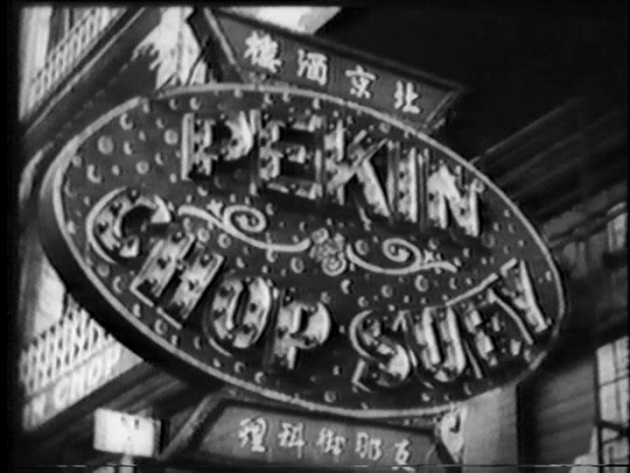
Secrets of Chinatown
An example from the exclusionist era of the Chinese Immigration Act is Secrets of Chinatown (1935, Fred C. Newmeyer), a cheaply made “quota quickie” financed by an American studio for distribution in the U.K. to satisfy the quota for “British product,” which at that time included films made in Commonwealth countries. Heavily influenced by the Fu Manchu and other “yellow peril” stories, the film’s Chinese characters, several of whom are played by white actors in “yellowface” makeup, can be divided into those who are dangerous and those who seem friendly and westernized, but are really even more dangerous. They split their time between killing people, smuggling narcotics into Canada and enslaving young and blonde white women. The signifiers used to denote Chineseness are Chinese lettering, dress, food and language. Early on, the film establishes its location with an actual shot of a Vancouver Chinatown street, with a pan of the Chinese-lettered signs of the shops, which then dissolves into the sign for the Pekin Chop Suey restaurant where the first murder occurs.
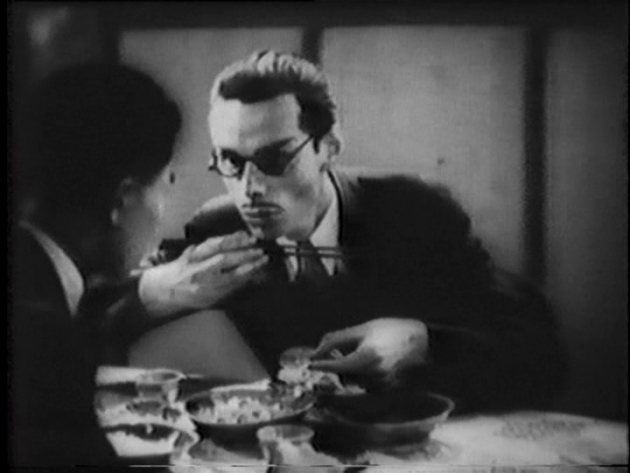
Secrets of Chinatown
The patrons eat with chopsticks, wear Chinese clothes and murmur in a sinister manner to each other in a language that is largely unintelligible, but is definitely not English. At least one actor, who finds a warning symbol in his bowl, is clearly speaking Japanese. Of course, it is possible the filmmakers believed their audience would not be too worried about this, if they even noticed themselves. Like Double Happiness, Secrets of Chinatown can be divided into three spaces. The Chinese spaces include a restaurant, a shop and, for those looking for the heights of exotica, a hidden temple used for human sacrifice.
More importantly, these spaces are strictly Chinese, and non-Chinese who enter without a gang of policeman by their side are taking their lives in their hands. The public spaces are white, and any Chinese within them, such as a servant lurking by the Police Commissioner’s door, are to be regarded with suspicion. Finally, there are some intermediate spaces, such as dark alleys, which are safe enough as long as there are no Chinese around to kidnap you, which is what happens to several characters here.
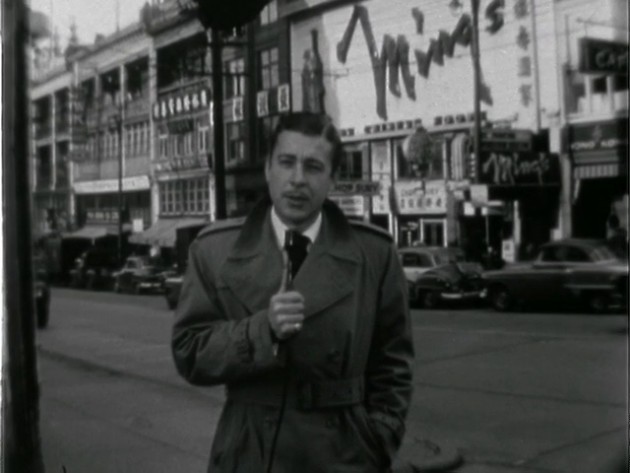
Vancouver’s Chinatown
Vancouver’s Chinatown (1954, Bernard Devlin), a National Film Board of Canada documentary from the relatively liberal post-1947 era, is characteristic of its time in both its attempt to undermine the more racist assumptions found in films such as Secrets of Chinatown and its fascination with the exotic Chinese. Much more than Double Happiness, this film is concerned with showing that the newly-enfranchised Chinese population is harmless and “just like everybody else.” A meeting of a local community organization shows a group of middle-aged men in business suits sitting soberly around a table listening to a speaker. The language spoken may be Cantonese, but the visual message is that the proceedings are as dull and unexceptional as a Kiwanis or Rotary luncheon. In a bizarre interview, the group’s president guilelessly provides a history of anti-Chinese racism in Canada, capping it off with a grateful acknowledgement that Chinese Canadians now have the right to vote and a cheerful, if startling, concession that in the incidence of racism there “may have been fault on both sides.”
This film also uses an early shot of a Chinatown street with Chinese-lettered shop signs as a signifier of place, but demystifies it through a visit with Chinese typesetters who explain the intricacies of the language, and follows this up with a visit to a Chinese medicine shop guided by a friendly customer who turns out to be the world yo-yo champion.
Despite this consciously liberal, and occasionally patronizing, attempt to debunk “far-fetched stories told about the Chinese Canadian,” the lure of exoticism remains. There is an extended visit to a pharmacy to examine enticingly strange Chinese medicine (“I never knew such things existed,” the reporter remarks) and the film finishes with a performance of a Lion Dance, which is hilariously mis-identified as a Dragon Dance at the end of the previous segment before they set the record straight. Clearly made with good intentions, the film shows that there was still a lot of progress that needed to be made.
Unlike these earlier films, Double Happiness expresses an “insider” view that shows awareness, if not of these films, then of the assumptions they express. Shum’s younger characters are acutely aware of the stereotypes linked with these assumptions and play with them. Jade’s friend Lisa refers to her boyfriend as a “rice king,” slang for a white man who only dates Asian women, and plays to his orientalist fascination with Chinese otherness, while Jade herself pretends to be a sweet Asian girl who doesn’t speak English when she first meets boyfriend-to-be Mark. These instances are made more complex because, besides being part of the series of masquerades that run through the film, they express alternative strategies in dealing with white Vancouverites. Ty points out that “Lisa willingly plays the role of the exotic Oriental for her boyfriend” in order to “assimilate and be accepted by the dominant culture” (71), but Jade’s manipulation of stereotypes is a claim to be accepted on her own terms. As Edward O’Neill writes, she “performs her assigned ethnic and gender role so that she can destroy that role by revealing it to have been a performance, a stereotype mimicked in advance of the other’s expectations” (57). Many of the typical signifiers are used to denote the film’s Chinese spaces (food, dress, language), although it is significant that there is no pan of a Chinatown street’s signs and Mrs. Mar’s shop, where Jade and Lisa work, is only seen from the inside.
Identity as Performance in a Canadian Context
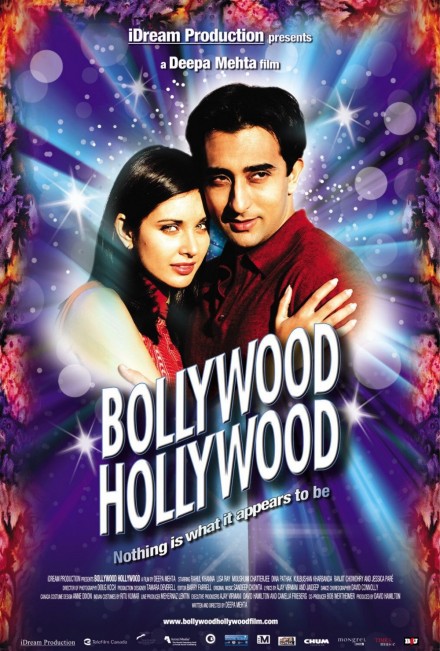
A view from the inside of an ethnic diaspora is also offered by Bollywood/Hollywood, a film containing interesting similarities and differences with Double Happiness. An important similarity is their relationship with Canada’s multiculturalism policy. If Mina Shum was the first Chinese Canadian woman to direct a feature film in 1994 (Ty 69), Deepa Mehta was the first Indo-Canadian woman to direct a feature film when she made Sam & Me in 1991. The proximity of the dates is not a coincidence. Shum has said she was “very fortunate that the Canadian funding bodies were focusing on people of colour in the early 90s” (Spaner 136), a governmental policy that also benefited directors such as Clément Virgo (Rude, 1995) and Srinivas Krishna (Masala, 1992). Besides their funding, the defining characteristic that Double Happiness and Bollywood/Hollywood have in common and make them a useful source for comparison is their shared concern with the tensions between ethnic and individual identities from an insider’s perspective.
The idea of relating this concern with ethnic identity to performance is also central to both films. Eva Rueschmann notes about Double Happiness that “Jade’s experience as an aspiring actress emphasizes the performance of Chinese Canadian identity inside and outside her household” (191). In fact, Jade’s story can be seen as a series of performances related to finding an appropriate ethnic identity: auditions where she is either too Chinese or not Chinese enough, fantasies where she recites roles her ethnicity will almost certainly prevent her from playing, playing the dutiful daughter at home, pretending to be a shy Chinese girl stereotype when she first meets Mark, and going on a pretend date with the seemingly perfect Chinese suitor Andrew, who it turns out is performing at least as much as Jade. As Edward R. O’Neill comments, everyone “is impersonating someone or something for some audience, and identity is figured not only as a performance, but as a strategic one” (58). Andrew is a closeted gay man (when in the Chinese community); Lisa plays a Suzie Wong-type playmate for her “rice king” boyfriend; Jade’s mother pretends not to miss her disowned son Winston; Ah Hong has a secret lover and child; and Jade’s sister Pearl pretends to be a “straight A” student. Even Quo seems to be performing a role at times, for example when he does not immediately acknowledge Jade’s standing at his shoulder with a plate of buns even though he is clearly aware of her presence (he also “performs” when he sings a karaoke version of “MacArthur Park”). Bollywood/Hollywood, which features Rahul Seth as Rahul, a westernized Indian man under family pressure to marry who hires a woman to pretend to be his fiancée, shares both the ethnic marriage and masquerading themes with Shum’s film. That the fiancée in question (played by Lisa Ray) is an Indian woman pretending to be Spanish and therefore needing to be coached in “how to be Indian” emphasizes a similar appreciation of the performative component in ethnic identity.
Representing Transnational Spaces
Double Happiness has been described by Brenda Austin-Smith as an example of transnational cinema (205). These are films that are often intimately concerned with exiled figures who are negotiating relations with a distant home country and a new host society. As Hamid Naficy writes, “freed from the old constraints, they are ‘deterritorialized.’ Yet they continue to be in the grips of both the old and the new, the before and the after” (208). In these films, space is often used to express this conflict, with a restricted home space that offers a “confining but comforting” haven in the face of what is perceived to be “a foreign, often hostile, host culture” contrasted with “spaces of immensity” (211-213). The Chinese spaces in Double Happiness, particularly Jade’s family home, are a good example of the confining space that offers safety in the face of assimilation. The frame is often crowded with groups of guests, usually eating one of a multitude of Chinese dishes. Even when it is just the family, they are often seen in tight frames, notably in the dinner scene shot from a revolving lazy Susan in the middle of a table, which frames the family members individually as they eat.
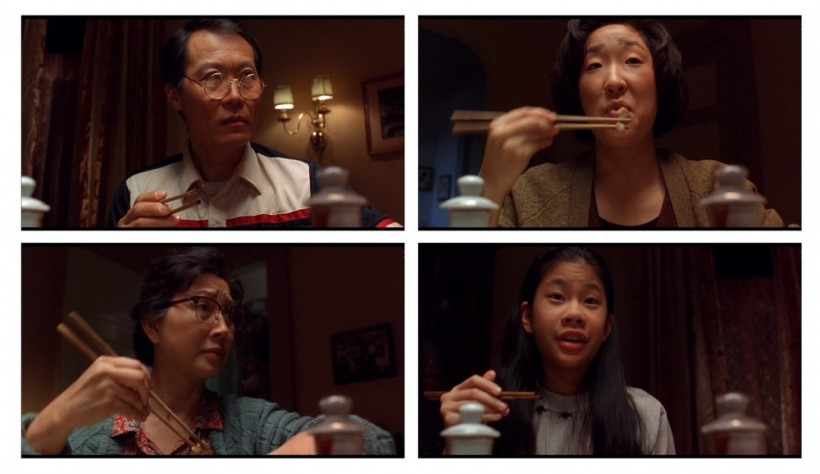
Austin-Smith points out that at the climactic dinner scene, “Jade’s body is not fully contained in the crowded frame for the first few seconds,” (209) her bursting out of the frame a visual metaphor for her imminent declaration that she will leave home. Jade is at times able to exert control over this home environment. When she rehearses, the lighting changes and it is as if she is transported out of her home.
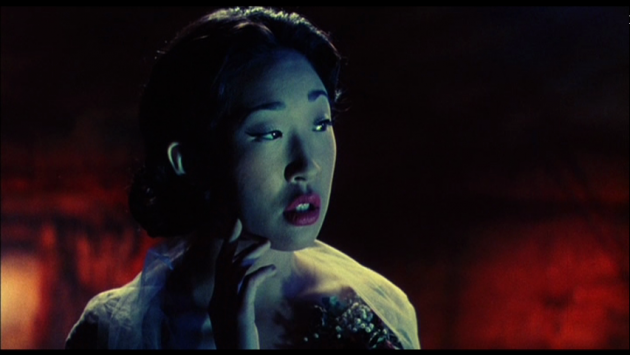
Interestingly, this fantasy space is darker and lit by blue spotlights, matching the colour schemes of the intermediate spaces such as the rehearsal room where she is asked to use a Chinese accent, the area outside the club where she meets Mark or, for that matter, Mark’s bedroom. Ty describes Jade’s fantasies as “a vision of a theatrical world where there is racially unbiased casting and equal opportunity to work for all ethnic subjects” (78). This is true, but more specifically it is a vision of Jade exerting a control over the intermediate spaces which she does not always have. It is also significant that both of these fantasy episodes are cut short by members of Jade’s family calling for her. That it is their voices that pull her out of this idealized space suggests that Shum sees the family, and the diasporic community it represents, as the major hindrance to Jade fulfilling her dreams.
For Austin-Smith, the exteriors in the film are equally confining, as “very few outdoors scenes in Double Happiness take place in a setting that is in any way expansive” (209). Her argument here is problematic, because it is possible to read several exterior scenes, most of which begin in a long shot that emphasizes the space around Jade, as being episodes of liberation. An early example is after her successful audition, when her giddiness over the possibilities she sees before her is expressed through a backward zoom which frames her in an area that includes a railway crossing.
As this is accompanied by the sudden intense sound of a passing train, it would not be hard to receive the impression that Jade is going places. The later sequence where she unexpectedly meets Mark at the swings also begins in a wide framing, as does a scene where she meets Mark after an audition and he gives her the encouragement she never gets from her parents.
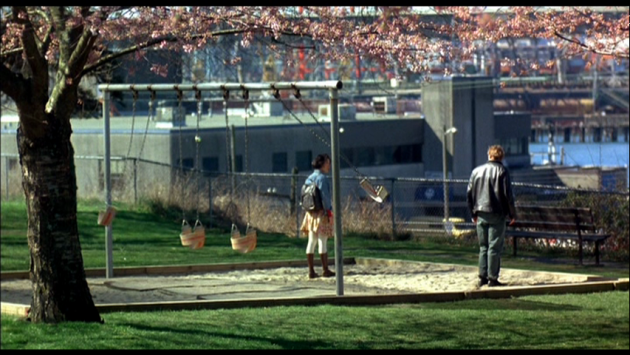
It is interesting that when he shows up at Jade’s door soon after, he is now tightly framed and their embrace is interrupted by her family’s return. The freedom of action available in the liberated area is impossible in Jade’s home (Chinese) space. It is also noteworthy that her second arranged date ends in an exterior scene when, in a long shot, we see the car stop and Jade get out before a tracking shot follows her as she breaks into a metaphorical run toward freedom.
Another important exterior scene begins in a wide frame showing Mark and Jade by the waterfront. When she tells them they have to break up because of her family, not only does the frame become tighter, but they are standing by some wooden pillars that are certainly intended to recall prison bars, as her family encroaches on the open space.
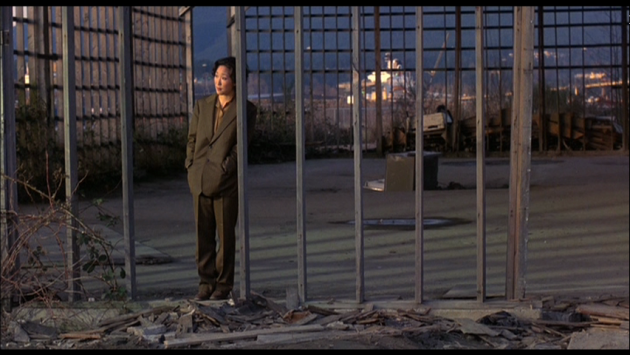
While Bollywood/Hollywood can also be considered an example of transnational cinema, its representation of space is completely different from Double Happiness. The home space here is anything but confined, as Rahul divides his time between a spacious downtown Toronto apartment and the family mansion, which has a ballroom, an enormous staircase, an expansive garden and an Olympic-size swimming pool. Nor is there any real distinction between public (host community) and private (ethnic community) space. A traveling shot down a commercial Toronto street shows block after block of Indian shops selling luxury goods.
While the crowd at the mansion for Rahul’s sister’s bridal sing-song is primarily, but not exclusively, Indian, there is a mix of ethnicities at the groom’s party held in Rahul’s apartment and the musical number there in which guests of all colours mix Bollywood and Hollywood dance steps can be seen as a celebration of multiculturalism.
The conclusion Rahul reaches is also different than Jade’s. Where she rejects the rigid definition of Chinese identity that her father insists on, Rahul receives dispensation from his traditionalist grandmother to seek a more relaxed version of Indian-ness. And, unlike Jade, he will end up marrying an Indian girl and preserving the traditional family.
Genre and Production Contexts
One possible reason that the films offer different resolutions to the conflicts over identity can be found in their genre and production contexts. Where Double Happiness has a playful experimentation characteristic of North American independent cinema (while borrowing heavily from the genre conventions of romantic comedy), Bollywood/Hollywood is a largely satiric variation on Bollywood musicals, which it references relentlessly throughout its running time. Mehta’s film can even be related to a Bollywood subgenre that has become increasingly popular, which Brian Larkin describes as “a new genre of films centered on the diasporic experience and an increased awareness of the economic strength of the Indian market abroad” (174). Crucial to these films was not only the prosperous lives that the expatriate Indians were living, but the amount of freedom they had. This may have been reinforced by the film being Mehta’s first project after being forced to abandon production of Water (which she eventually succeeded in filming in 2005) in the face of riots, sabotage and death threats in her native India. So while Rahul may wrestle with the same identity questions as Jade, he does it in an idealized Canada where there is no racism or poverty and where people are free to mold their own identities. In a sense, all of Rahul’s Toronto is equivalent to the liberated spaces in Jade’s Vancouver.
Levitin argues that one aspect of this Bollywood subgenre is “a hybridization of styles and frequently a lack of attention to place, turning precise locales into generic cities” (2002: 271). This generic sense of place is actually truer of Double Happiness. While informed viewers can spot references to specific places and identify specific locations, there are no shots of easily identifiable Vancouver landmarks such as Chinatown, the city skyline, the mountains or the harbor. Exteriors tend to be generic: a city street, a park, a railway crossing, a shoreline, the outside of an anonymous club. Where Bollywood/Hollywood featured shots of the CN Tower and other local landmarks and was peppered with references to the Blue Jays and other local ephemera, there is nothing equivalent in Shum’s film. This may have been a deliberate strategy to broaden the film’s commercial prospects or was perhaps a reflection of the production practices of most of the films made in Vancouver at the time Shum was filming, Hollywood runaway productions in which the city was typically camouflaged to look American. It is possible that Vancouver was shot generically because it was the common practice for almost all the films made in town at the time.
South of the Border
Interesting comparisons in this regard are Chinese American films with thematic similarities to Double Happiness. As Wing Chung Ng writes, “Chinese immigration into Vancouver and the rest of Canada was, and still is, part of a larger regional and then global movement of the Chinese population outside of China” (8), marking Vancouver not only as a city in Canada but as the site of part of a transnational global Chinese diaspora. Given this, comparisons to other parts of the North American diaspora become useful.
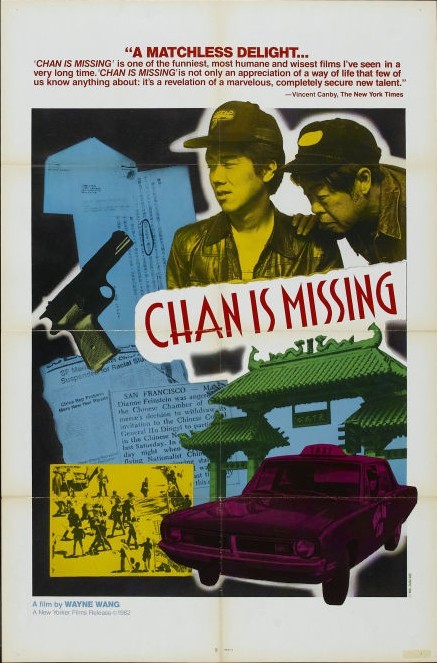
Chan Is Missing deals with questions of identity as a taxi driver and his nephew attempt to track down a recently arrived immigrant with whom they have a business deal. This slim plotline is largely an excuse to explore the geography and history of San Francisco’s Chinese community and the different way their shared ethnicity is performed. The missing Chan in fact turns out to be a man whose life was a series of performances in which he unsuccessfully tried to fit in to his adopted country. Like Double Happiness, the younger generation is shown to be much more westernized, but, unlike Shum’s film, there is no cause for rebellion. Instead, Chinese culture is seen as source of strength and celebrated in a manner which is closer to Bollywood/Hollywood’s treatment of Indian culture than Jade’s impatience with its rigid rules. Also, while Chan Is Missing features a sharp critique of anti-Chinese racism, no specific racist incident is portrayed in the narrative. There is also no division between home and public space, because the film’s entire space is Chinese. There are only a handful of non-Chinese faces (mostly in restaurants eating Chinese food) and the many shots of San Francisco’s Chinatown show it to be bustling and sprawling.
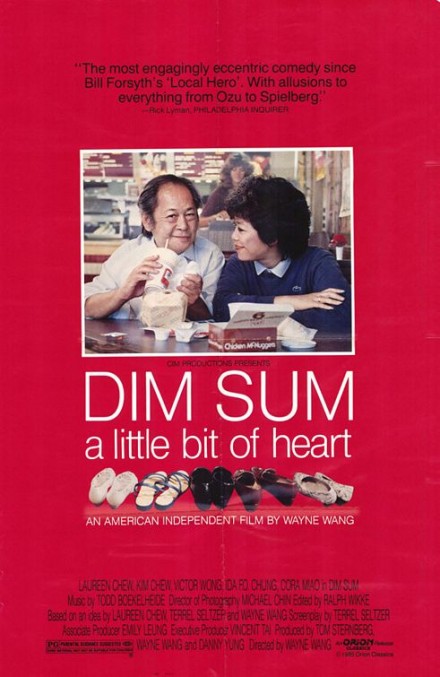
Dim Sum in some ways is more similar to Double Happiness, as it features a battle of wills between a Chinese mother and daughter (played by real life mother and daughter Kim and Laureen Chew) over the daughter’s marital intentions. The film does draw a distinction between Chinese (home) space and public space, but it is nicely understated and summed up in shots of Western shoes that are worn outside the house Geraldine shares with her mother and the Chinese shoes they wear inside. But the home space is not portrayed as confining, as one of the main reasons the daughter is reluctant to marry is that there is nobody to take care of the mother if she leaves San Francisco and joins her boyfriend (both Chinese and a doctor, so not a rebellious choice) in Los Angeles. Nor does the public space offer the difficulties needed to be overcome or possibilities of liberation that it does to Jade. While there are shots of Chinatown and other prominent landmarks, such as the Golden Gate Bridge, this family home is in the suburbs. But it is not the confining and comforting fortress defending against assimilation that is portrayed in Double Happiness, or even to some extent Bollywood/Hollywood. This film gives a sense that the Chinese characters are at home not just in Chinatown, but all parts of the city. For example, an extended shot of a rippling river accompanied by Chinese music on the soundtrack seems to claim the whole city as welcome space.
Another major difference between Wang’s films and Double Happiness is the treatment of the older generation. While the portrait of Jade’s father is not entirely negative, with scenes such as the karaoke party making it impossible to see him simply as a patriarchal tyrant, it is also clear Shum considers him to be in the wrong. As Jacqueline Levitin notes, the early dinner table scene in which he criticizes his daughter Pearl for using the word “fact” (which he confused with “fuck”) demonstrates from the start of the film that his patriarchal authority is “inappropriate linguistically and culturally; limited English and cultural inflexibility render him blind and deaf to what is happening even at his own dinner table” (2007: 279). This is in sharp contrast to the treatment of Geraldine’s mother in Dim Sum, who has even more limited English, but makes up for it through her kindness and wisdom. Not surprisingly, the ending is completely different too, and again much closer to Bollywood/Hollywood. Geraldine finally follows her mother’s wishes and marries her Chinese doctor, and everybody is happier as a result and settles down to a nice Chinese meal.
Some of the differences between the films are likely the result of historical circumstances specific to Vancouver, Toronto and San Francisco, but it is striking how much sharper a break is portrayed in Double Happiness, and how much more necessary it seems. The reality of racism is much more present in Shum’s film, as is the double marginality of her lead character as being both a visible minority in a white majority city and a female owing loyalty to a patriarchal culture. It would be difficult not to relate these differences to the relationship between the Chinese and host communities in Vancouver and Shum’s own experiences as a Chinese Canadian woman. Eva Rueschmann writes that “Jade’s coming-of-age and eventual moving out of her family home can be seen as a miniaturized version of the immigrant journey, a variation on her parents’ own migration out of a traditional Chinese cultural context” (191). But it is more than that, as Jade’s ethnic identity has an oppressive dimension that is presented almost entirely in satiric terms in Bollywood/Hollywood and is absent from Wayne Wang’s films. Double Happiness at times shows uneasiness with the drastic step of cutting ties to family and community, but the ending, which shows Jade sitting in the corner of a wide framing that exaggerates the space of her new apartment, clearly shows her embarking on an adventure. It is no accident that the curtain she hangs up is not something with a Chinese pattern that might signal a desire to maintain some link to her culture, but has pictures of Marilyn Monroe. She will still have to negotiate the intermediate space to establish a version of an ethnic identity she is comfortable with, but the haven she will be doing it from will be an expansive space where all things might be possible and both non-Chinese (her boyfriend Mark, who she is seen leaving a message for at the end) and Chinese (her second generation friends Alan and Lisa, who she says will be coming over) are equally welcome.
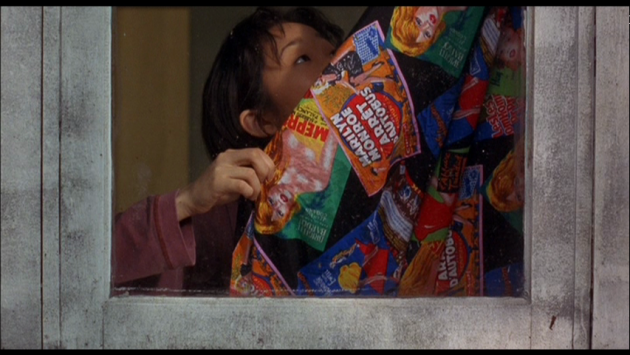
*This essay is derived in part from the second chapter of my Masters Thesis, Chinese Diasporic Films: A Case Study in Transnational Cinema, completed within the Film Studies program in the Mel Hoppenheim School of Cinema at Concordia University in 2013.
Works Cited
Austin-Smith, Brenda. “Women, Liminality, and ‘Unhomeliness’ in the Films of Mina Shum.” The Gendered Screen. Eds. Brenda Austin-Smith and George Melnyk. Waterloo, ON: Wilfrid Laurier University Press, 2010, 203-216.
Blomley, Nicholas. “Back to the Land.” Unsettling the City: Urban Land and the Politics of Property. New York, NY: Routledge, 2004, 139-156.
Delany, Paul. “Introduction: Vancouver as a Postmodern City.” Vancouver: Representing the Postmodern City. Vancouver, BC: Arsenal Pulp Press, 1994, 1-24.
Gasher, Mike. Hollywood North: The Feature Film Industry in British Columbia. Vancouver, BC: University of British Columbia Press, 2002.
Jim, Alice Ming Wai. “Thoughts on the Meaning of Return: HKG < > YVR.” Journal of Visual Culture 6.3 (2007): 333-341.
Larkin, Brian. “Itineraries of Indian Cinema: African Videos, Bollywood, and Global Media.” Multiculturalism, Postcoloniality and Transnational Media. Eds. Ella Shohat and Robert Stam. Piscataway, NJ: Rutgers University Press, 2003, 170-192.
Levitin, Jacqueline. “Deepa Mehta as Transnational Filmmaker or You Can’t Go Home Again.” North of Everything: English-Canadian Cinema Since 1980. Eds. William Beard and Jerry White. Edmonton, AB: University of Alberta Press, 2002, 270-293.
—-. “Mina Shum: The ‘Chinese’ Films and Identities.” Great Canadian Film Directors. Ed. George Melnyk. Edmonton, AB: University of Alberta Press, 2007, 271-291.
Naficy, Hamid. “Phobic Spaces and Liminal Panics: Independent Transnational Film Genre.” Multiculturalism, Postcoloniality and Transnational Media. Eds. Ella Shohat and Robert Stam. Piscataway, NJ: Rutgers University Press, 2003, 203-226.
Ng, Wing Chung. The Chinese in Vancouver, 1945-80: The Pursuit of Identity and Power. Vancouver, BC: University of British Columbia Press, 1999.
O’Neill, Edward R. “Identity, Mimicry and Transtextuality in Mina Shum’s Double Happiness and Quentin Lee and Justin Lin’s Shopping for Fangs.” Cineaction (1997): 50-62.
Rueschmann, Eva. “Mediating Worlds/Migrating Identities: Representing Home, Diaspora and Identity in Recent Asian American and Asian Canadian Woman’s Film.” Moving Pictures, Migrating Identities. Ed. Eva Rueschmann. Jackson, MI: University of Mississippi Press, 2003, 180-194.
Spaner, David. Dreaming in the Rain. Vancouver, BC: Arsenal Pulp Press, 2003.
Ty, Eleanor. “Rescripting Hollywood: Performativity and Ethnic Identity in Mina Shum’s Double Happiness.” The Politics of the Visible in Asian North American Narratives. Toronto, ON: University of Toronto Press, 2004, 69-81.



